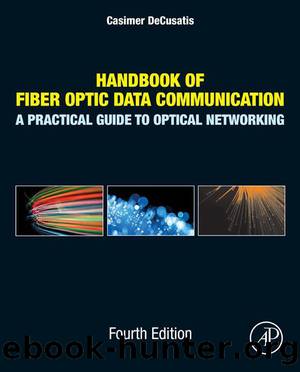Handbook of Fiber Optic Data Communication by DeCusatis Casimer

Author:DeCusatis, Casimer
Language: eng
Format: epub
ISBN: 9780124016958
Publisher: Elsevier Science
Published: 2013-08-15T16:00:00+00:00
The IEEE defined a set of data rates and media over which the data can be carried between stations. Older so-called standard 10/100 Base-T Ethernet and more modern versions define gigabit and higher rates over various optical fiber types and span lengths. These initial Ethernet variants used a shared media, coaxial cable, or copper twisted pair that communicated in both directions. In order to manage potential data packet collisions between stations, a method called carrier sense multiple access with collision detection (CSMA/CD) was devised. CSMA/CD is now obsolete as are its related shared media Ethernet variants (10BASE5, 10BASE2). Modern Ethernet networks built with switches and full-duplex connections no longer utilize CSMA/CD though it is still supported for backward compatibility. IEEE Std 802.3, which defines all Ethernet variants, for historical reasons still bears the title “carrier sense multiple access with collision detection (CSMA/CD) access method and physical layer specifications.”
The variants of Ethernet most commonly in use as of this writing are as follows:
Standard Ethernet (10 Mb): Standard Ethernet or 10BASE-T operates over twisted-pair Category 3 (Cat 3) or Category 5 (Cat 5) cable. The twists prevent crosstalk, which is the electromagnetic interference (EMI) produced from neighboring wire pairs and external sources. A category rating such as Cat 3 or Cat 5 indicates various grades of cable signal integrity with higher numbers corresponding to higher grades. Standard 10 Mb Ethernet provides the basic transmission rate or “wire speed” for half-duplex and full-duplex network devices.
Fast Ethernet (100 Mb): Fast Ethernet or 100BASE-TX uses Cat 5 and Cat 5e (for enhanced) cable for the greater signal integrity required at higher transmission speeds. Fast Ethernet is capable of carrying basic network traffic along with voice services. Cat 5 and Cat 5e are both capable of 100 MHz signaling as used in 100 Mb networking. Although there are several Fast Ethernet standards, 100BASE-TX or twisted pair is by far the most commonly available form in use today. The success of Fast Ethernet is due to its ability to coexist with established network installations, and many adopters today support all standard and Fast Ethernet designs because of autosensing and autonegotiation strategies.
Gigabit Ethernet (GbE): Just as Fast Ethernet eventually augmented and replaced standard Ethernet designs, GbE is taking over as the LAN standard. GbE describes technologies that deliver data rates at a speedy one billion (1,073,741,824, actually 230–1) bits per second. GbE is carried primarily across optical fiber and short-haul copper backbones, into which 10/100 Mb cards can also feed directly. Although it was once a data rate available only to enterprise grade equipment, GbE has become commonplace for most commercial products from notebooks to Peripheral Component Interconnect (PCI) network cards and switches. In fact, GbE is such a commodity that modern notebook and desktop PCs include it by default.
10 GbE: At the upper end of Ethernet speeds 10 gigabit Ethernet (10 GbE or 10 GBASE-T) can be found. It operates at a wire speed 10 binary orders of magnitude faster than GbE (or 240–1 bits per second).
Download
This site does not store any files on its server. We only index and link to content provided by other sites. Please contact the content providers to delete copyright contents if any and email us, we'll remove relevant links or contents immediately.
Grails in Action by Glen Smith Peter Ledbrook(9812)
Sass and Compass in Action by Wynn Netherland Nathan Weizenbaum Chris Eppstein Brandon Mathis(9243)
Kotlin in Action by Dmitry Jemerov(8237)
Azure Containers Explained by Wesley Haakman & Richard Hooper(7455)
Configuring Windows Server Hybrid Advanced Services Exam Ref AZ-801 by Chris Gill(7445)
Running Windows Containers on AWS by Marcio Morales(7000)
Microsoft 365 Identity and Services Exam Guide MS-100 by Aaron Guilmette(5405)
Microsoft Cybersecurity Architect Exam Ref SC-100 by Dwayne Natwick(5229)
Combating Crime on the Dark Web by Nearchos Nearchou(4985)
The Ruby Workshop by Akshat Paul Peter Philips Dániel Szabó and Cheyne Wallace(4678)
Management Strategies for the Cloud Revolution: How Cloud Computing Is Transforming Business and Why You Can't Afford to Be Left Behind by Charles Babcock(4528)
Python for Security and Networking - Third Edition by José Manuel Ortega(4239)
The Age of Surveillance Capitalism by Shoshana Zuboff(4214)
Learn Wireshark by Lisa Bock(4136)
The Ultimate Docker Container Book by Schenker Gabriel N.;(3890)
Learn Windows PowerShell in a Month of Lunches by Don Jones(3725)
DevSecOps in Practice with VMware Tanzu by Parth Pandit & Robert Hardt(3578)
Windows Ransomware Detection and Protection by Marius Sandbu(3548)
Blockchain Basics by Daniel Drescher(3511)
